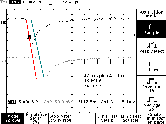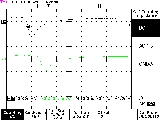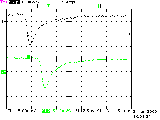

The IC comes from Phillips, here is the PDF data sheet.
Looking at the specifications, this preamplifier seems to be well suited for our application. It is housed in a small 5cm x 5cm x 2cm metal box with two BNC connectors and a 6V power supply. The fact that it is AC coupled does not hurt very much since in the DSC waveform analysis the baseline gets subtracted automatically.
To verify that it works with our signals, I took a look at the T1:4 target signal with cosmics. Before it enters the DSC, I splitted it. One branch goes directly to the digital scope, while the other branch goes through the amplifier and then to the scope. Here is a typical pulse:

The upper signal is the original signal, while the lower one is the amplified. Note the factor of 10 difference in the Y-scale of the scope. One can observe a 2ns propagation delay of the amplifier, where 1ns comes from an additional cable leaving 1ns to the amplifier. The waveform is very nicely reproduced and even the signal-to-noise ratio is smaller after the amplification, indicating that some pickup noise gets coupled in at the scope. Unfortunately I cannot test the amplifier at higher rates, but I don't expect any problems there.
We decided to build enough amplifier channels (~25) for all our beam counters, we are currently just studying if we should build individual boxes or put several (4, 10 ?) channels into one box, properly de- coupled.
The use of an AC coupled device might cause problems, because this shifts our signal baslines on the trigger branch side. So it's better to use DC coupled preamps. There are two amplifiers available at PSI: PSI FA105 Fast Amplifier and LeCroy 612A.
There is a module available from PSI electronics pool, PSI FA105 Fast Amplifier. This is a single width NIM module with 12 bipolar fast DC coupled amplifiers (discrete layout).
|
INPUT |
Lemo connector range 6 10mV to 6 5000mV (short time) input impedance 50 V protected againstinstantaneous impulse to 6 25V |
|
Attenuator (optional) |
1:1.05 1:1.12 1:1.25 1:1.58 1:2 1:2.5 1:3.16 1:4 1:6.3 1:10 1:39 |
|
OUTPUT |
2 Lemo connectors in parallel max. output signal 6 5000mV across 50 V both outputs must be terminated with 50 V |
|
Gain |
10 x 6 5%, T c = +0.01% / K |
|
Bandwidth (full power) |
150 MHz (3dB), t r = tf = 2.5 ns, typ. 2 ns |
|
Linearity |
6 0.5% integral (for medium frequency) |
|
Noise level |
[ 1.0mV p-p referenced to the input, typ. 0.5 mVp-p |
|
Dynamic range |
5000:1 |
|
DC offset |
input, output [ 3mV, T c = +0.15 mV / K |
|
Over/undershoot |
[ 6 10%, typ. [ 6 6% |
|
Propagation delay |
~ 5 ns |
|
Temperature range |
0...40 degrees C |
|
Dimension |
single width NIM module |
|
Power Requirements |
+12 V 1.0 A - 12 V 1.0 A |
This amplifier was tested with the sum signals from Target T1:4 with Cosmics. The signal was splitted with a matched splitter on the DSC input. Channel 1 of the TEKTRONIX digital scope (next figure) shows the original signal, channel 2 shows the amplified signal. There is a factor 10 in the y-scale. For a gain of 10 the signals should look the same.


PSI Fast Amplifier FA105 (DC-coupled)
left: Signal from summed target T1:4 (cosmics). Channel 1: original signal,
channel 2: amplified signal.
right: Average over 20 signals.
This picture shows us, that is seems to be possible to use this amplifier. We will have some pulse shaping, especially from the risetime and reduction of double pulse resolution.
The LeCroy 612A was originally designed for fast photomultiplier pulses. There is to be no alternative module available (internal information by PSI electronics people). The price per channel is ~200 SFr. It is known, that the lifetime of the amplifiers is not too long, but these chips are available from PSI electronics pool.
Here you can find the amplifier's datasheet.
The 612A was tested same way as the FA105 with the sum signals from Target T1:4 with Cosmics. The signal was splitted with a matched splitter on the DSC input. Channel 1 of the TEKTRONIX digital scope (next figure) shows the original signal, channel 2 shows the amplified signal. There is a factor 10 in the y-scale. For a gain of 10 the signals should look the same.


LeCroy 612A Photomultiplier Amplifier
left: Signal from summed target T1:4 (cosmics). Channel 1: original signal,
channel 2: amplified signal.
right: Average over 20 signals.
In comparison with the FA500 the pulse shaping is less. Especially the risetime is the same for the original and the amplified pulse. The fixed gain factor of 10 should be okay. Small variations can be achieved by changing the PM high voltage.

S. Ritt, 19 Jan 2000